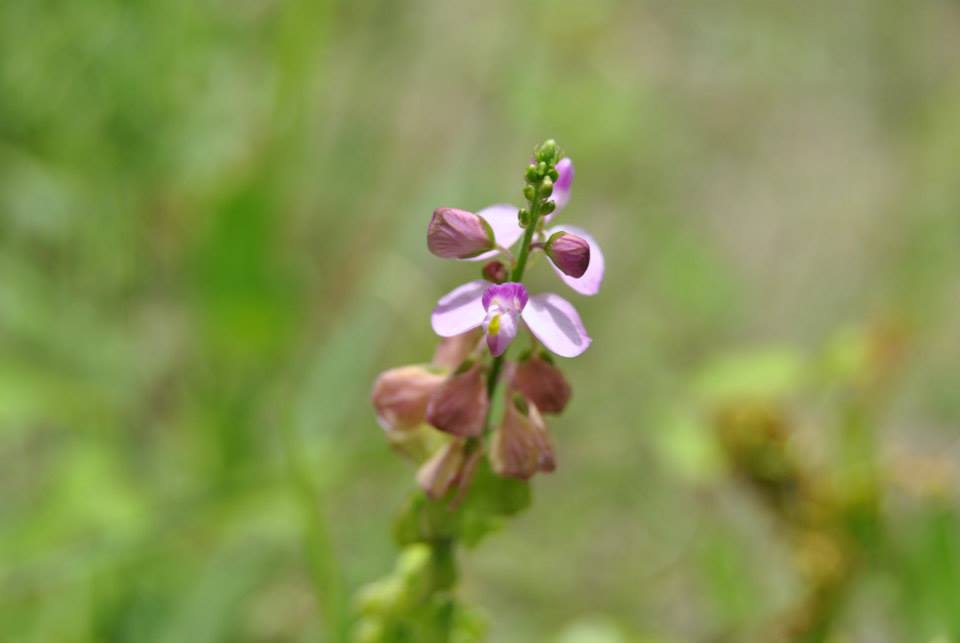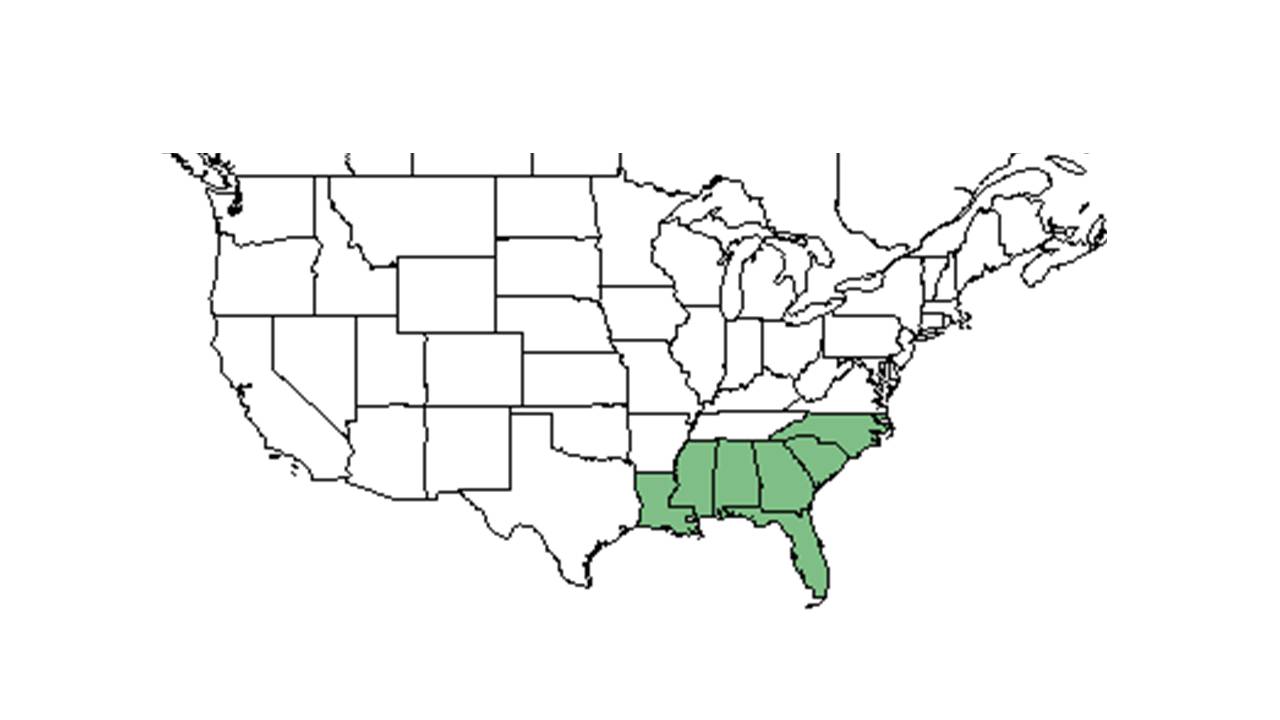Polygala grandiflora
| Polygala grandiflora | |
|---|---|

| |
| Photo taken by Michelle M. Smith | |
| Scientific classification | |
| Kingdom: | Plantae |
| Division: | Magnoliophyta – Flowering plants |
| Class: | Magnoliopsida – Dicotyledons |
| Order: | Polygalales |
| Family: | Polygalaceae |
| Genus: | Polygala |
| Species: | P. grandiflora |
| Binomial name | |
| Polygala grandiflora Walter | |

| |
| Natural range of Polygala grandiflora from USDA NRCS Plants Database. | |
Common name: Showy milkwort
Contents
Taxonomic notes
Description
Perennial that grows 6-12 inches in height including the elongated spike of pink or rosy flowers. Flowers average width of less than half an inch.[1]
The root system of Polygala grandiflora includes root tubers which store non-structural carbohydrates (NSC) important for both resprouting following fire and persisting during long periods of fire exclusion.[2]. Diaz-Toribio and Putz (2021) recorded this species to have an NSC concentration of 385.3 mg/g (ranking 8 out of 100 species studied) and water content of 46.6% (ranking 21 out of 100 species studied).[2]
According to Diaz-Torbio and Putz (2021), Polygala grandiflora has root tubers with a below-ground to above-ground biomass ratio of 0.45 and nonstructural carbohydrate concentration of 385.3 mg g-1.[3]
Distribution
Ecology
Habitat
This species has been found growing within calcareous glades, upland pine woods, longleaf pine-scrub oak sand ridges, savannas, and sandhill communities (Deyrup et al 2002, FSU Herbarium). It has also been observed growing in swales of slash pine plantations (FSU Herbarium).
P. grandiflora decreased in occurrence in response to soil disturbance by agriculture in southwest Georgia savannas. It has shown resistance to regrowth in reestablished native savanna that was disturbed by agricultural practices.[4]
Phenology
This species has been observed flowering and fruiting in May (FSU Herbarium).Cultivated plants may be in continuous bloom from earliest spring to late autumn, or even year round in southern Florida.[5]
Seed dispersal
This species is thought to be dispersed by ants and/or explosive dehiscence. [6] P. grandiflora seeds were observed to be readily retrieved by fire ants in a 2013 study on seed dispersal by the imported fire ant species in the southeast.[7]
Seed bank and germination
Fire ecology
Populations of Polygala grandiflora have been known to persist through repeated annual burns.[8][9] Flowers within two months of burning in early summer (Robertson).
Pollination
The following Hymenoptera families and species were observed visiting flowers of Polygala grandiflora at Archbold Biological Station (Deyrup 2015):
Megachilidae: Anthidiellum notatum rufomaculatum
Use by animals
Deyrup observed this bee, Anthidiellum notatum rufimaculatum, on P. grandiflora (Deyrup et al 2002).Lilliputian moths pupa have been observed consuming the seeds inside the capsules.[10]
Diseases and parasites
Conservation and Management
Cultivation and restoration
Photo Gallery
References and notes
Deyrup, M.A. and N.D. 2015. Database of observations of Hymenoptera visitations to flowers of plants on Archbold Biological Station, Florida, USA.
Deyrup, M. J. E., and Beth Norden (2002). "The diversity and floral hosts of bees at the Archbold Biological Station, Florida (Hymenoptera: Apoidea)." Insecta mundi 16(1-3).
Florida State University Robert K. Godfrey Herbarium database. URL: http://herbarium.bio.fsu.edu. Last accessed: June 2014. Collectors: Ann F. Johnson, Wilson Baker, Roy Komarek, R. A. Norris, Robert K. Godfrey, A. Gholson Jr., Chris Cooksey, Kevin Oakes, and Lisa Keppner. States and Counties: Florida: Calhoun, Gadsden, Jackson, Leon, Sarasota, Wakulla, and Washington. Georgia: Grady and Thomas.
Robertson, Kevin M. 2014. Personal observation at Pebble Hill Plantation, Grady County, GA.
- ↑ Osorio R. 2004 The Wildflower Garden Showy Milkwort Palmetto 22(4):10-11
- ↑ 2.0 2.1 Diaz-Toribio, M.H. and F. E. Putz 2021. Underground carbohydrate stores and storage organs in fire-maintained longleaf pine savannas in Florida, USA. American Journal of Botany 108: 432-442.
- ↑ Diaz‐Toribio, M. H. and F. E. Putz. 2021. Underground carbohydrate stores and storage organs in fire‐maintained longleaf pine savannas in Florida, USA. American Journal of Botany 108(3):432-442.
- ↑ Kirkman, L.K., K.L. Coffey, R.J. Mitchell, and E.B. Moser. Ground Cover Recovery Patterns and Life-History Traits: Implications for Restoration Obstacles and Opportunities in a Species-Rich Savanna. (2004). Journal of Ecology 92(3):409-421.
- ↑ Osorio R. 2004 The Wildflower Garden Showy Milkwort Palmetto 22(4):10-11
- ↑ Kirkman, L. Katherine. Unpublished database of seed dispersal mode of plants found in Coastal Plain longleaf pine-grasslands of the Jones Ecological Research Center, Georgia.
- ↑ Cumberland, M.S. and Kirkman, L.K. 2013. The effects of the red imported fire ant on seed fate in the longleaf pine ecosystem. Springer Science+Business Media Dordrecht. Plant Ecol 214: 717-724.
- ↑ Robertson, K.M. Unpublished data collected from Pebble Hill Fire Plots, Pebble Hill Plantation, Thomasville, Georgia.
- ↑ Glitzenstein, J. S., D. R. Streng, R. E. Masters, K. M. Robertson and S. M. Hermann 2012. Fire-frequency effects on vegetation in north Florida pinelands: Another look at the long-term Stoddard Fire Research Plots at Tall Timbers Research Station. Forest Ecology and Management 264: 197-209.
- ↑ Osorio R. 2004 The Wildflower Garden Showy Milkwort Palmetto 22(4):10-11.